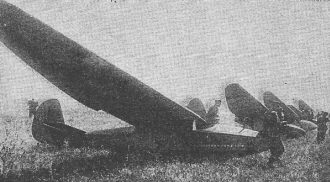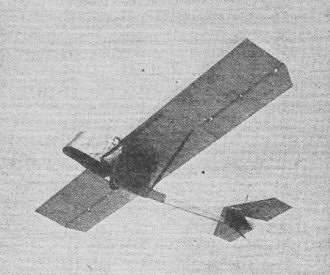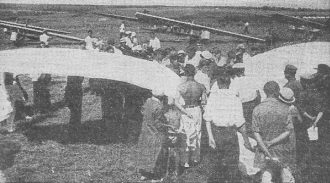|
The spell checker sure gets a
workout with stories from these vintage magazines, specially ones from in the 1920s
and 1930s. Common words were sometimes spelled a bit differently than today, and
other words are rarely seen anymore. And then there is the mix of foreign words
and names of people and places relating to World War I, which had only ended
ten to fifteen years prior (1919). Such is the case here in this 1934 issue of
Flying
Aces magazine in a piece called "Gliding in Russia," and even more so in the fictional
wartime stories like "The Ghost
from G−2." The "Iron Curtain"
is a term adopted at the end of World War II to describe the imaginary line
through Europe that divided Russia's Communist world from the Western Democracies;
however, Iron Curtain was also used in World War I. Russia had for a long time
endeavored to keep its citizens from learning about the benefits earned by peoples
of free nations, including superior medical care, food, clothing, appliances, transportation,
housing, mental health, etc. At the same time it kept outsiders from reporting on
the internal situation of its territories. You can be sure that stories like this
one were orchestrated by the
Bolsheviks
of the Politburo for the benefit
of invited media to project an image of a thriving, content, open society. In fact
they were what would during the Vietnam era become known as a
Potemkin Village -
a scenario constructed to give a positive public face to an otherwise pathetic
existence.
Gliding in Russia - What the U. S. S. R. Has Done to Develop Gliding

One of those strange-looking tailless planes. Here you see the
tailless glider "Parabel" - designed by the Russian, Tchernovski - which made its
first flight at the Ninth All Union Gliding Meet held in the Crimea last fall.
Illustrated Fact Article
By Kurt K. Siemon
Author of "Gliding in Germany."
Russia can look back on only ten years of gliding history - yet enormous strides
have been made in the development of this sport. Since that day back in 1923, when
Moscow saw the birth of the first gliding club, many meets have been held and records
spectacularly broken. Read this month the history of some of the high spots in gliding,
as the Soviets have seen them.
Photographs from Soviet Photo Agency
Now that we as a nation have recognized Soviet Russia, we are more interested
than ever before in the accomplishments of that nation. In fifteen years of desperate
efforts against the resistance of world capital and world opinion, the leaders of
Soviet Russia have succeeded in bringing their nation to the fore with rapid strides.
Vast achievements in its various industries are cited. Aircraft factories are working
full blast to produce bigger and better airplanes. And gliders are playing an important
part, for Russia realizes how valuable gliding is for preliminary flight training
at relatively low cost.
Soviet Russia looks back upon ten years of gliding history. In 1923 the first
gliding club was organized in Moscow. In the same year the first Soviet gliding
meet was held at Koktebel on the Crimean Peninsula on the northern shore of the
Black Sea. The following year a couple of Russian pilots went to the German meet
at the Wasserkuppe in the Rhoen, and here they studied German methods, exchanged
ideas and experience. The German pilots were invited for a return visit to Russia
for the following year. They accepted, and in 1925 a German gliding expedition went
to the Crimea.
Enthusiastic about the excellent Soviet soaring site, the German boys made gliding
history The late Ferdinand Schulz, Germany's gliding ace at that time, established
a new world's endurance record of twelve hours and six minutes, and Nehring, flying
the Darmstadt "Consul," put the world distance record up to fifteen miles. The Germans,
having demonstrated the great possibilities of the Soviet gliding terrain, were
instrumental in establishing the Uzum-Syot Mountain, renamed Mount Klementiev, with
its many ridges, as the center of Soviet gliding activities. Under the supervision
of Russia's best soaring pilot, Stepanchenok, a gliding school was established there.

Lined up for the start. Here are a few of the gliders which helped
to make the Ninth All Union Gliding Meet interesting. Sixteen different types of
gliding machines took part in this meet.

The Kharkov record-breaking glider, "Ossoaviakhim DR-5," after
taking off. This machine has two seats - one for a passenger - and holds the world
altitude record for a flight with a passenger.

One of the gliders used as training ships in the Moscow district
of Russia. To these the young air fans come from building model planes - and from
them they go to real airplanes - and become full-fledged pilots. It's all a matter
of training.

More gliders in the Moscow section of Russia. Here you see gliding
enthusiasts examining the waving wings of the Letatlin, the most technically interesting
glider of all.

Famous folk in Russia's gliding world. At the left is Eidemann,
high official of the Society for the Promotion of Aviation and Chemistry. And at
the right is the best glider pilot of Russia - Stepanchenok.
Many other clubs and schools were founded in other parts of the Union, too, and
the seventh Soviet gliding meet in 1931 was a real contest. From all parts of the
U.S.S.R., 218 pilots and 27 machines found their way to that semi-island, the Crimea.
The steady breezes sweeping in from the Black Sea - sometimes without any shifting
in direction for days - provided a hard competition. Gone were the days of timid
experiments.
This meet was organized in three different categories: beginners, advanced glider
pilot and soaring pilots. After the meeting, however, it was realized that an entirely
different classification had to be made, and also that the number of contestants
had to be reduced in order to enable the more talented pilots to make more flights
and, if possible, to stay aloft longer. To exercise good comradeship by giving everyone
in the group an equal chance to fly is all very well, but it limits the number of
flights for the individual. The less able members increase the hazard of damaging
the machines, too, and thus endanger the success of the group as a whole and retard
the progress of the program. For this reason no extraordinary performance was shown
this time.
The following year, from October 3rd to 9th, the eighth Soviet gliding contest
was held. A new system, worked out in the meantime, proved to be a great success.
During that time only forty pilots and twenty-two soaring planes took part, and
yet they flew a total sum of 760 hours, as against 100 the year before.
Osoaviakhim DR-5, a newly constructed two-seater, designed by Kovalenko and built
at the Kharkov airplane plant, soared to a new height of 6380 feet under the skillful
hands of Pleskoff, one of Russia's gliding aces. Gavrisch, another well-known soaring
pilot, climbed in the single-seater class to an altitude of 7325 feet, while Golowin
got the first prize for endurance with one passenger in the time of ten hours and
fifty-six minutes, Borodin managed to stay up for four hours and one minute with
two passengers.
For the first time in Soviet gliding history, an aerial train was demonstrated
during the meet. Towed by an airplane, Stepanchenok flew in Glider G-9, a distance
of 1055 miles from Moscow to Koktebel in nineteen hours and ten minutes. This able
Russian pilot distinguished himself also in different other fields. In a two-hour
flight, besides flying upside-down for one minute and eight seconds, he made 115
loops between turns, wing-overs and spins. On another flight Stepanchenok established
a new world record of 29 consecutive loops, a record which has since been broken
by the American glider ace, Jack O'Meara, with 46 loops.
The year 1933 can be called the turning point in the history of Soviet gliding.
After ten years, real mass interest and support was apparent. In the middle of last
August, about fifty to sixty soaring planes gathered at Mount Clementiev at the
opening of the ninth All Union Conference of Gliders, combined with the fourth contest
of airplane model builders.
Among the well designed and well built ships were five tailless planes. One of
these, an entry from Leningrad, constructed by Kostenko, had a wing span of forty-four
and a half feet and weighed only two hundred and twenty pounds, including instruments
and parachute. Another quite unusual design was incorporated in the tailless "Parabel,"
by Tchernovski. But the most interesting glider was found to be the "Letatlin,"
which was shaped like a bird, similar to the early experiments of the pioneers of
twenty to thirty years ago. It had waving wings, which were moved by the pilot.
This experimental job is one more attempt at the perfect human flight
Of quite a novel design was the sea-glider, "HA-2 Alkanis," constructed by Gribovski
and built at the Tushino glider plant near Moscow. Sea-gliders should find a wide
application in the Soviet Union, with its abundance of rivers and lakes. The best
construction was found in plane "GH-2," a high-performance ship built by the Komsomol
(young communist) Grushev. Another outstanding designer is Antonov, who at an age
of twenty-nine has already built thirteen planes. Then there was the beautiful two-seater
for stunting by Kovalenko and the huge passenger glider, "MKB-7," for six passengers.
During the contest, the komsomol-built "2-K," manned by the komsomol pilot, Simikow,
covered a distance of 30.4 miles, thus establishing a new Russian record for straight
flying. At another time the same boy gained a new altitude of 8860 feet. Pilot Anokhim
was credited with a flight of 36.6 miles, returning to the starting point. He also
bettered the endurance record by staying up for seventeen hours.
The most sensational flight was again achieved by a komsomol. Early in the morning
of August 15th, a boy named Judin arrived with his glider "G-9" on Mt. Klementiev,
having covered a distance of 2230 miles over the Oremburg-Moscow-Koktebel route
in 38 hours and 56 minutes, reaching an average speed of 74.4 miles per hour while
being towed by a motorplane. Over the field, he cut loose at an altitude of 1500
feet and, after a couple of circles, landed gracefully near the hangar. The flying
conditions were very unfavorable. Low-hanging clouds, contrary winds and frequent
rain made the flight very difficult, especially between Eisk and Koktebel, where
he was forced to go down to 500 feet.
How was it possible for Soviet Russia to advance that far in only ten years of
gliding? The answer is the Osoaviakhim - a society for aerial and chemical defense.
This vast organization, with a membership of two and a half millions, grew out of
the Society of Friends of the Red Air Fleet. Russia, being surrounded by a chain
of not too friendly neighbors and open enemies with enormous armies and large air
fleets, constantly has been in the fear of being attacked. In such a case, the civil
population would naturally suffer most. Therefore, one of the main tasks of the
Osoaviakhim is to prepare the people, especially those in big cities, against the
dangers of the cruel gas and other chemical war methods of today. To repulse any
possible attack, an efficient air fleet was needed.
The Osoaviakhim has about fifty thousand clubs or branches all over the country.
Members of these units try to get the big masses interested in aviation, raise funds
for research work in aviation and chemistry, and build planes for army, navy and
civil aviation.
In 1929 the Osoaviakhim took over gliding. Realizing the possibilities of this
great air sport, it began a great drive for gliding activities in all its branches.
A special glider factory was erected to supply the different clubs and schools with
training ships and soarers. The planes are delivered either completed or in parts,
to be assembled by the groups. One month after the opening of the first school in
Koktebel; ten youngsters graduated as glider pilots. Last year, in thirty glider
schools of the U.S.S.R. 2500 workers and komsomols became glider pilots. The end
of this year is expected to bring the total sum of all Russian glider pilots up
to 30,000, and those who build and fly models up to 500,000.
As in the United States and many other countries, airplane model sport is very
popular among young Russia, and there is a separate organization taking care of
these activities for boys and girls up to the age of eighteen. The members of this
organization are known as komsomols. Nearly every young person in Russia is anxious
to learn to fly, but the Osoaviakhim selects only those best qualified for this
work, which is about one out of every six applicants. The course takes about four
to five weeks of training. Some of the best glider pilots have a chance to get motor
plane instruction, which is generally completed in six months, while training to
fly for the army and navy is finished in from two to three years.
Next to Germany, Russia is, of all nations, doing the most serious work in gliding.
The Soviet government fully realizes its importance in aviation as a whole. Therefore,
future aircraft workers, engineers and pilots will be taken mainly from the ranks
of those trained in gliding. They are true to the slogan of the Osoaviakhim: "From
Airplane Models to Gliders - From Gliders to Motor Planes."
Posted May 14, 2022
|